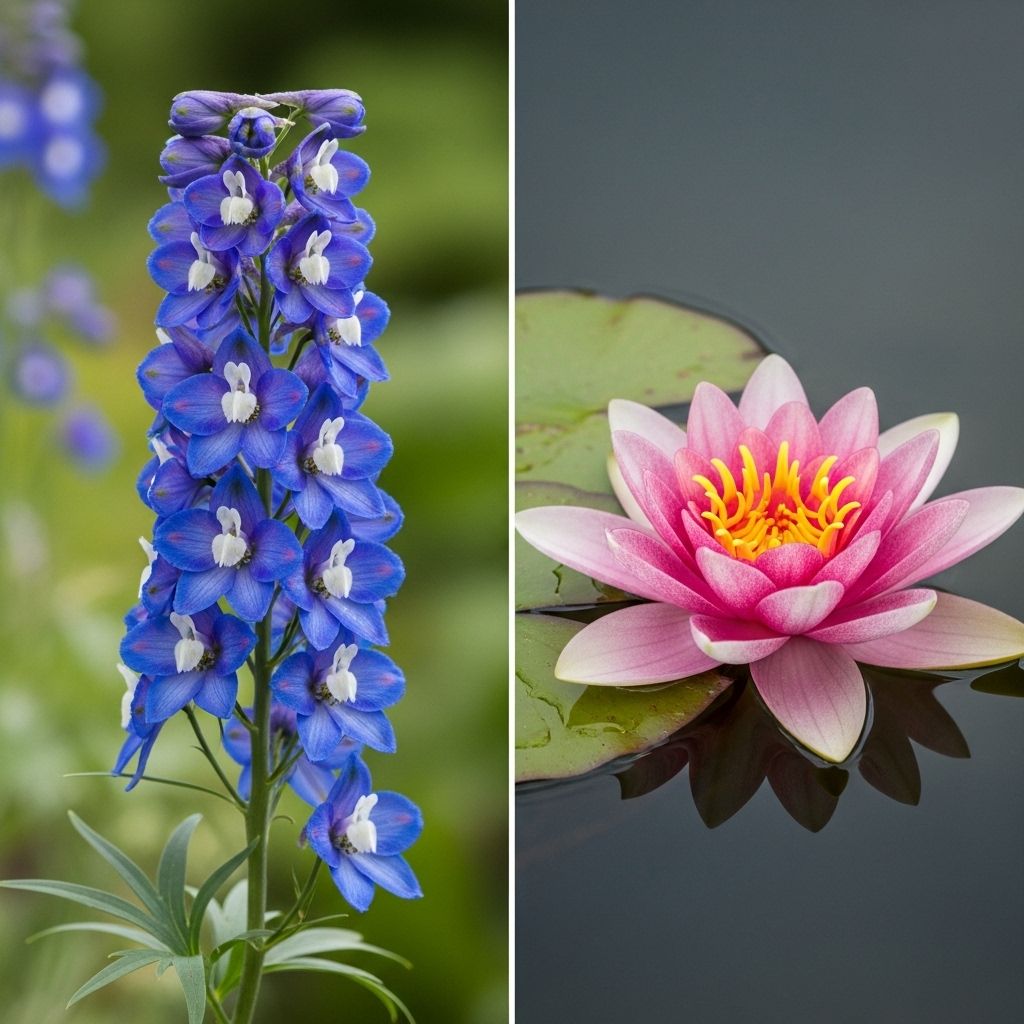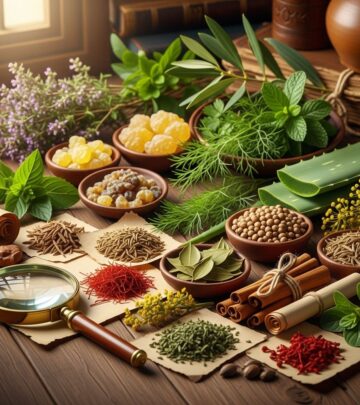July Birth Flowers: 2 Stunning Blooms And Their Symbolism
Discover the beauty and symbolism behind July's stunning birth flowers that brighten summer gardens

Image: HearthJunction Design Team
As summer reaches its peak, July showcases some of the most spectacular flowers of the season. Like birthstones, birth flowers carry special meaning for those born during specific months, creating a connection between people and the natural world. Each month traditionally has two birth flowers, accounting for cultural differences and regional availability. For those celebrating birthdays in July, two magnificent blooms represent this warm, vibrant month: the stately larkspur and the elegant water lily.
The Significance of Birth Flowers
The tradition of associating specific flowers with birth months has an interesting but somewhat mysterious history. While some claim the practice dates back to ancient Rome, there’s limited historical evidence to confirm this origin. More likely, the concept evolved from the Victorian-era practice of floriography – the language of flowers – which became popular during the 1800s.
During the Victorian period, strict social etiquette limited direct communication, especially regarding romantic feelings. Sending or wearing certain flowers became a way to convey coded messages. Early floriography guides like Charlotte de la Tour’s 1819 book Le Langage des Fleurs and Kate Greenaway’s 1884 publication The Language of Flowers cataloged various blooms and their meanings.
Interestingly, the symbolism of flowers could vary between sources, influenced by a blend of folklore, literature, mythology, and perhaps the author’s personal interpretation. Generally, birth flowers associated with each month typically bloom during that time of year – though exceptions exist. For July-born individuals, the larkspur and water lily serve as botanical representatives, each carrying unique symbolism and beauty.
Larkspur: July’s Primary Birth Flower
Larkspur (Consolida) stands as July’s primary birth flower, gracing summer gardens with its tall, distinctive spires of blossoms. These striking flowers grow on a single stalk and typically display vibrant purple-blue hues, though varieties in white and pink also exist. With their dramatic vertical growth habit and clusters of delicate blooms, larkspurs make a bold statement in any garden setting.
Symbolic Meaning of Larkspur
The larkspur carries rich symbolism that makes it especially meaningful for those born in July. This beautiful flower has long represented:
- Positivity and optimism
- Loving bonds and strong attachments
- Dedication and commitment
- Sincerity and open-heartedness
- Lightheartedness and youthful spirit
These positive associations make larkspur an uplifting birth flower, suggesting that July-born individuals possess bright, sincere personalities and form deep, meaningful connections with others.
Larkspur in Mythology and History
The larkspur’s cultural significance extends deep into mythology and legend. According to Greek mythology, the first larkspur sprouted from the blood of Ajax the Great after he fell during the famous Battle of Troy. This origin story connects the flower to themes of bravery and sacrifice.
Roman legends offer another fascinating origin tale. According to these stories, the sea god Neptune transformed an endangered dolphin into the larkspur flower to protect it from harm. This divine intervention explains the flower’s distinctive shape – before blooming, larkspur buds resemble the form of a dolphin. In fact, the perennial version of larkspur, known as delphinium, derives its name from the Greek word for ‘dolphin’ in reference to this resemblance.
Growing Larkspur in Your Garden
Beyond its symbolic value, larkspur offers practical benefits for garden enthusiasts. These nectar-rich flowers attract important pollinators including butterflies, bees, and hummingbirds, making them a valuable addition to any wildlife-friendly garden space. Their tall, architectural form adds vertical interest to garden beds and borders.
When planting larkspur, consider the following tips:
- Location: Choose a site with full sun to partial shade
- Soil: Provide well-draining soil with moderate fertility
- Timing: Plant seeds directly in the garden in early spring or fall
- Spacing: Allow 12-18 inches between plants to accommodate their upright growth
- Care: Water regularly but avoid overwatering to prevent root rot
Note that larkspur plants are toxic if ingested, so exercise caution if you have pets or small children. The beauty and symbolic significance, however, make this July birth flower a worthwhile addition to garden spaces for those who can grow it safely.
Water Lily: July’s Secondary Birth Flower
The water lily (Nymphaea) serves as July’s secondary birth flower, floating serenely on still waters with its spectacular blooms. These aquatic plants feature large, star-shaped flowers in various colors including white, pink, yellow, and purple, set against circular pad-like leaves that rest on the water’s surface. The water lily creates a peaceful, meditative atmosphere in aquatic gardens and natural water features.
Symbolic Meaning of Water Lilies
Water lilies carry profound symbolism across various cultures, making them a meaningful birth flower for July-born individuals. These aquatic blooms commonly represent:
- Rebirth and renewal
- Purity of heart and spirit
- Enlightenment and spiritual awakening
- Peace and tranquility
- Beauty rising from challenging circumstances
The symbolism of enlightenment comes from the water lily’s life cycle – many varieties close their flowers at night, sinking beneath the water, only to rise and reopen with the morning sun. This daily renewal represents the journey toward spiritual awareness and personal growth.
Cultural Significance of Water Lilies
Water lilies hold special meaning in numerous cultures worldwide. In ancient Egyptian civilization, these flowers were sacred, associated with rebirth and the afterlife. The blue lotus, a type of water lily, frequently appeared in Egyptian art and religious contexts.
In Buddhist traditions, the water lily (often called lotus in this context) symbolizes purity and enlightenment. The Buddha is frequently depicted seated on a lotus throne, representing spiritual elevation above worldly attachments. The plant’s ability to produce immaculate blooms despite growing in muddy waters serves as a powerful metaphor for maintaining spiritual purity amid life’s challenges.
In various Asian cultures, water lilies continue to represent divine beauty and spiritual awakening, appearing frequently in art, literature, and religious contexts.
Growing Water Lilies
For those with suitable water features, growing water lilies can create a living connection to this July birth flower. Consider these guidelines when cultivating water lilies:
- Environment: Water lilies require still or very slow-moving water
- Depth: Different varieties thrive at different depths; research your specific type
- Container: Use wide, shallow containers with heavy garden soil
- Sunlight: Provide at least 6 hours of direct sunlight daily
- Maintenance: Remove dead leaves and flowers promptly to maintain water quality
Water lilies not only add beauty to water gardens but also provide practical benefits by shading the water surface, reducing algae growth, and creating habitat for aquatic wildlife.
Celebrating July Birthdays with Flowers
For those celebrating July birthdays, incorporating these birth flowers into celebrations creates meaningful connections to nature’s seasonal offerings. Consider these ways to honor July’s birth flowers:
- Include larkspur in birthday bouquets or floral arrangements
- Gift potted water lilies for those with water gardens or features
- Incorporate floral motifs into birthday cards or decorations
- Share the symbolic meanings of these flowers with the birthday celebrant
- Plant larkspur seeds as a living reminder of the special day
Like zodiac signs, birth flowers offer insight into personality traits and characteristics associated with different times of year. For July-born individuals, the larkspur suggests positivity and dedication, while the water lily represents spiritual depth and renewal – a beautiful combination of qualities to celebrate.
July’s Birth Flowers in the Garden
Adding July’s birth flowers to your garden creates a personal connection to the month’s natural beauty. Larkspur makes an excellent addition to cottage gardens, cutting gardens, and wildflower meadows. Its tall spires provide vertical interest and attract beneficial pollinators throughout the summer months.
For those with ponds, water features, or even large containers that can hold water, water lilies create stunning focal points. Their floating blooms and large, round leaves transform ordinary water features into tranquil retreats reminiscent of Monet’s famous garden paintings.
Together, these July birth flowers complement each other beautifully – the vertical, architectural larkspur providing height and drama, while the horizontal, floating water lily offers peaceful, contemplative beauty. This combination reflects the balanced duality often found in nature’s design.
Frequently Asked Questions About July Birth Flowers
Q: What is the difference between larkspur and delphinium?
A: The common name “larkspur” may refer to flowers of the genus Consolida, which tend to be annuals, or to flowers of the genus Delphinium, which are typically perennials. These plants are very closely related, with Consolida often considered a distinct group within the Delphinium genus. Both feature similar spire-like flower clusters and are associated with July birthdays.
Q: Are larkspur flowers safe to have around pets?
A: No, larkspur plants contain toxic compounds that can be harmful if ingested by pets or humans. If you have curious pets or small children, it’s best to admire these flowers in public gardens or keep them in areas inaccessible to pets and children.
Q: Can water lilies grow in any water feature?
A: Water lilies require specific conditions to thrive. They need still or very slow-moving water, adequate sunlight (at least 6 hours daily), and appropriate water depth based on the variety. Small container water gardens can support dwarf varieties, while larger ponds accommodate standard water lilies.
Q: What colors are available for July’s birth flowers?
A: Larkspurs commonly appear in purple-blue shades, but also come in white, pink, and occasionally red varieties. Water lilies offer even more color diversity, including white, pink, yellow, purple, and even rare blue varieties, depending on the species and cultivar.
Q: What other birth month symbols are associated with July?
A: Besides the larkspur and water lily as birth flowers, July’s birthstone is the ruby, which symbolizes passion and protection. The zodiac signs associated with July are Cancer (until July 22) and Leo (from July 23 onward). In some traditions, the eagle is considered July’s symbolic bird.
References
- https://www.countryliving.com/life/entertainment/a61192107/july-birth-flowers-meaning/
- https://www.countryliving.com/gardening/garden-ideas/g64244263/birth-flowers-by-month-meaning-details/
- https://www.almanac.com/content/july-birth-flowers
- https://www.aol.com/july-two-birth-flowers-know-161100846.html
- https://www.farmersalmanac.com/july-birth-month-symbols-and-fun-facts
Read full bio of medha deb











